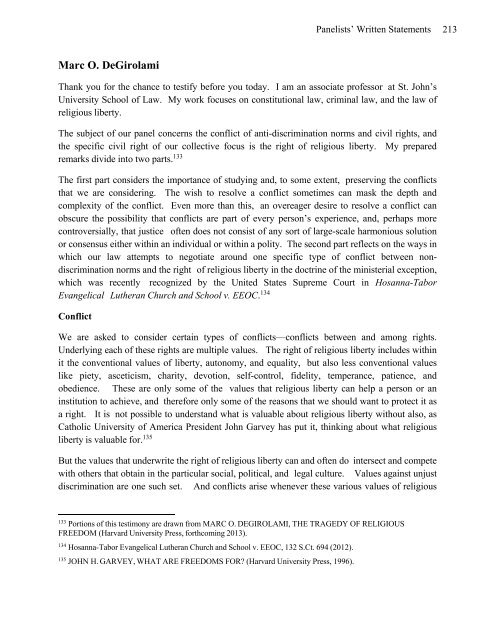PEACEFUL COEXISTENCE
2cgDkdT
2cgDkdT
Create successful ePaper yourself
Turn your PDF publications into a flip-book with our unique Google optimized e-Paper software.
Panelists’ Written Statements<br />
215<br />
desires of ours clash, and when they do a court is forced to choose between them, between one<br />
constitutional good and another one. 141<br />
It is true, and everyone agrees that it is true, that when there are certain particularly powerful<br />
interests at stake—interests in protecting the weak from physical harm and abuse, for example—<br />
those interests should always trump any countervailing interest. But most conflicts between<br />
religious liberty and nondiscrimination norms are not of this extreme character and should not be<br />
analogized to the most extreme circumstances. Likewise, nothing that I have said about the<br />
justice of conflict negates the importance of compromise, particularly legislative compromise.<br />
But compromise does not mean harmony, or the absence of tension. A good compromise is one<br />
where the tension between conflicting forces and impulses remains, even after the compromise,<br />
perceptible and vivid. Because of the nature of conflict as constitutive of our lives, it is probable<br />
that our own lives could be characterized as a series of compromises between competing values.<br />
Much the same may be said of the institutions of civil society, very much including our legal<br />
institutions.<br />
The Ministerial Exception<br />
In light of the clash of values I have described, one may well wonder how a court is to proceed in<br />
negotiating these clashes as a matter of constitutional adjudication. No matter how important<br />
preserving conflict may be, adjudication requires the termination of a specific dispute, and so it is<br />
necessary to consider what courts ought to say in carrying out their obligations.<br />
The best way forward for courts—the way that permits them to preserve as much of an existing<br />
conflict between religious liberty and non-discrimination norms as possible while fulfilling the<br />
duties of their office—is to decide cases narrowly and with close attention both to our historical<br />
traditions and to the factual particulars that shape each specific dispute. In these types of cases,<br />
courts should avoid issuing decisions that imprint a single value or class of values (whether, for<br />
example, those of religious liberty or of nondiscrimination) as categorically superior to other<br />
values. Decisions that are informed by historical compromises and our national traditions, and<br />
that reflect careful consideration of factual particulars, are preferable to those which proceed by<br />
reference to the all-out vindication of an abstract value, such as liberty, equality, neutrality, nondiscrimination,<br />
or the separation of church and state, at the expense of all other goods.<br />
It is a fortuity that the Supreme Court’s most recent, unanimous, religious liberty case, Hosanna-<br />
Tabor Evangelical Lutheran Church and School v. EEOC, reflects just this approach to<br />
adjudication. As the Commission Members are aware, Hosanna-Tabor involved the issues of<br />
the existence and scope of the ministerial exception, a doctrine which recognizes that in certain<br />
contexts, the state’s interest in enforcing its nondiscrimination norms must be qualified by a<br />
141<br />
David H. Souter, Harvard Commencement Address, HARVARD GAZETTE (May 27, 2010), available at<br />
http://news.harvard.edu/gazette/story/2010/05/text-of-justice-david-souters-speech/.


